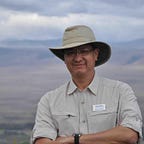When Faith Seeks Understanding — Paul in Malta
I have heard of Malta but knew very little about this speck of rock between Europe and Africa. Until I visited this crossroads of Afro-Euro maritime civilization. Western civilization is inextricably linked to Christianity. Although Jesus never left Israel and did not leave us any writings, Paul wrote half of the New Testament and traveled across the Roman Empire covering three sides of the Mediterranean Sea. Both Christianity and western civilization were shaped by Paul. It is impossible to understand Europe, the Americas, Australasia as well as much of Africa and Asia without a basic knowledge of Paul’s travels and thoughts.
What if you could go back in time and see the cave where St Paul spent 3 months under Roman arrest in Malta?
The year is AD 60 and Emperor Nero sits on the throne at Rome. Paul has been teaching about Jesus and his followers no longer worship the emperor as Son of God. The Roman governor arrested Paul for rebellion against the empire. But before he can be executed, the Apostle claimed his right as a Roman citizen to appear before the emperor, face to face. That was why he was on his way to Rome when a violent winter storm ⛈️ sank the ship he was on.
In the New Testament account, the writer of the Book of Acts recorded what happened. They were rescued by the locals of an island 🏝️ called Malta 🇲🇹. The shipwrecked soldiers, crew and passengers were shown kind hospitality. The Roman governor of Malta was called Publius. His father was deathly ill. Paul prayed for him, and the old man recovered. In time, Publius became a Jesus Follower like Paul, perhaps the first Maltese Christian. Modern archaeology affirms this account. It explains why Malta 🇲🇹 today is over 95% Christian, with 360 churches for a population of just 500,000 residents.
*************
In October, I traced the Footsteps of Paul in Malta and visited St Paul’s Grotto, the cave where the Apostle was under arrest. I arrived not by a sinking ship ⛵️ but on a Boeing 737. I made my way to the old city center where St Paul’s Church was located. A walled citadel called Mdina was next to its civilian town called Rabat. Here, I went down the ancient steps into St Paul’s Grotto, a cave identified as the location of Paul’s imprisonment.”
Perhaps I am drawn to Paul because of my own desire to learn from traveling to places far and wide, or perhaps like him, I have lived a life of the mind (investigation) coupled with a life of experiencing (exploration) this world, with all its complexities, irreconcilable realities and the collective memories of different cultures.
I bet Paul would have wanted to learn about Hinduism in India, Buddhism and Daoism in China, the Kyats of Myanmar, the Angkor Kingdom’s beliefs, the pre-Buddhist religious beliefs in Japan, Mongolia and Tibet, Voudon, shamanism, totemism, and animism in Sub-Saharan Africa, the diversity of pre-Christian Aztec, Inka and Mayan beliefs in Latin America, the beliefs of Inuits in the American, Canadian and Russian Arctic, the Melanesians of the Pacific, the Australasian Indigenous People and Māoris, the beliefs of North America’s First Nations, of the Vikings peoples and the Berbers of North Africa.
And I suspect that if Paul lived in the 21st century, he would delight in the iPhone, jet travel, iPads, the FitBit, Electric Scooters, DB12, perhaps drive a G-Wagen, and social media technologies such as FB, IG, X and Zoom.
As a Christian, this was an exciting pilgrimage of sorts. As an historian, it was a wonderful opportunity to piece together the texts of the Bible to the cultural history of Malta. As a scientist, I was able to trace the archaeological findings that led to this discovery.
Some say that there is insufficient evidence that St Paul arrived on the island as a Roman prisoner. However, others pointed out that Malta was indeed among the earliest identifiable Roman settlement with Christians. And the overwhelming percentage of Christians among the Maltese is circumstantial evidence of its Christian heritage. Supplemented by the ancient texts of the NT, I am more than convinced Paul was in Malta. Now whether the cave presented to the public is the actual location cannot be verified with scientific certainty. The event happened too long ago, and the grotto was venerated by millions of pilgrims before archaeological methods could cordon off the area to avoid evidential contamination. But, as my good professor Diogenes Allen, an ardent baseball fan, said, Malta in the “ballpark,” the approximate location where Paul was shipwrecked. Today, you can take a 90-minute ferry from Sicily and land on the island of Paul’s shipwreck and read Acts chapters 27–28.
St. Augustine wrote that Christianity is Faith Seeking Understanding. I am grateful that we live in such times, when advances in science and technology, both gifts of divine revelation, allow us to discover and learn so much about the history of our faith. For those of us who are eager to proclaim our faith, it is our privilege and responsibility to discover and separate the facts from the fictions of faith. This is how Thinking Things Through leads to a Faith that Seeks Understanding.
Check out my reels from this visit —
https://www.facebook.com/reel/332189819523306
and
